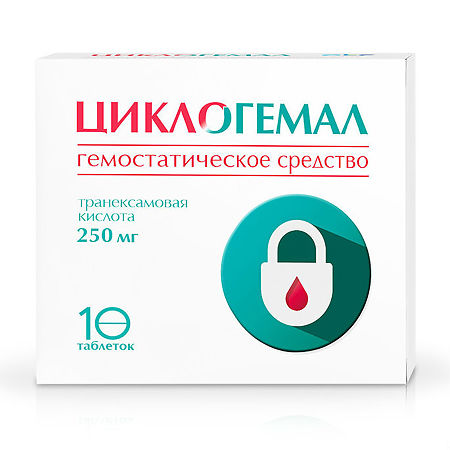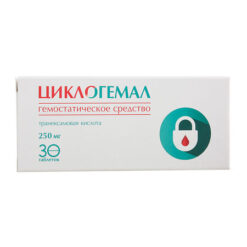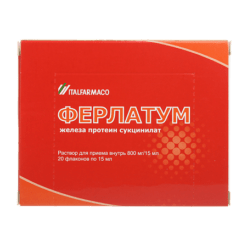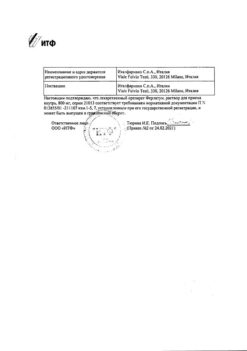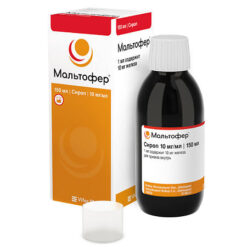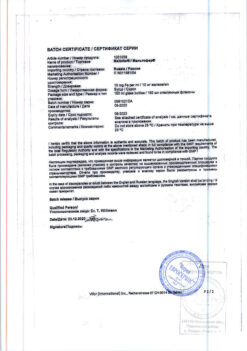No products in the cart.
Cyclogemal, 250 mg 10 pcs
€1.00
Out of stock
(E-mail when Stock is available)
Description
Antifibrinolytic agent. Tranexamic acid specifically inhibits the activation of profibrinolysin (plasminogen) and its conversion into fibrinolysin (plasmin). The antifibrinolytic activity of tranexamic acid is about 10 times higher than that of epsilon-aminocaproic acid.
Tranexamic acid has local and systemic hemostatic action in bleeding associated with increased fibrinolysis. In addition, tranexamic acid has analgesic, anti-allergic and anti-inflammatory effects by inhibiting the formation of kinins and other active peptides involved in allergic and inflammatory reactions.
Pharmacokinetics
The absorption with oral doses in the range of 0.5-2 g is 30-50%. Time to reach maximum concentration when oral administration of 0.5; 1 and 2 g tranexamic acid is 3 h, maximum concentration is 5.8 and 15 mcg/ml, respectively. Food intake has no effect on the absorption of tranexamic acid in the gastrointestinal tract.
The binding to plasma proteins (profibrinolysin) is less than 3%. Tranexamic acid does not bind to albumin. Therapeutic concentration of tranexamic acid in plasma is 5-10 mg/l.
The distribution in tissues is relatively uniform (the exception is cerebrospinal fluid, where the concentration is 1/10 of the plasma concentration); it penetrates through the placental barrier, into breast milk (about 1% of the concentration in maternal plasma), through the blood-brain barrier, into the intraarticular fluid and synovial membranes. The initial volume of distribution is 9-12 liters. Antifibrinolytic concentration in various tissues lasts for 17 hours, in plasma – up to 7-8 hours.
It is metabolized to a small extent. Pharmacokinetic curve has a three-phase shape with a half-life of 3 hours in the final phase. Total renal clearance is equal to plasma clearance (7 l/h). It is excreted by the kidneys (main route is glomerular filtration) – more than 95% unchanged during the first 12 hours.
Two metabolites of tranexamic acid have been identified: N-acetylated and deaminated derivative.
After oral administration of tranexamic acid at a dose of 10-15 mg/kg within the first hour, 3 h, 24 h, and 48 h, 1%, 7%,39%, and 79% of the administered dose, respectively, are eliminated.
There is a risk of cumulation of tranexamic acid if renal function is impaired.
Indications
Indications
Short-term treatment of bleeding associated with increased fibrinolysis in the following pathological conditions:
• Prostatectomy; surgical interventions on the bladder;
• Menorrhagia;
• Nosebleeds;
• Conization of the cervix;
• Traumatic hyphema (hemorrhage into the anterior chamber of the eye).
Prevention and treatment of bleeding in patients with hemophilia who undergo minor surgery (including tooth extraction).
Hereditary angioedema (prevention of exacerbations of the disease).
Bleeding during pregnancy.
Pharmacological effect
Pharmacological effect
Antifibrinolytic agent. Tranexamic acid specifically inhibits the activation of profibrinolysin (plasminogen) and its conversion to fibrinolysin (plasmin). The antifibrinolytic activity of tranexamic acid is approximately 10 times higher than that of epsilon-aminocaproic acid.
Tranexamic acid has a local and systemic hemostatic effect in bleeding associated with increased fibrinolysis. In addition, tranexamic acid has analgesic, antiallergic and anti-inflammatory effects due to the suppression of the formation of kinins and other active peptides involved in allergic and inflammatory reactions.
Pharmacokinetics
Absorption after oral administration of doses in the range of 0.5-2 g is 30-50%. Time to reach maximum concentration when taken orally 0.5; 1 and 2 g of tranexamic acid is 3 hours, the maximum concentration is 5.8 and 15 μg/ml, respectively. Food intake does not affect the absorption of tranexamic acid in the gastrointestinal tract.
Bonding with plasma proteins (profibrinolysine) is less than 3%. Tranexamic acid does not bind to albumin. The therapeutic concentration of tranexamic acid in blood plasma is 5-10 mg/l.
Distributed relatively evenly in tissues (with the exception of cerebrospinal fluid, where the concentration is 1/10 of the plasma concentration); penetrates the placental barrier, into breast milk (about 1% of the concentration in maternal plasma), through the blood-brain barrier, into the intra-articular fluid and synovial membranes. The initial volume of distribution is 9-12 l. Antifibrinolytic concentration in various tissues persists for 17 hours, in plasma – up to 7-8 hours.
Metabolized to a small extent. The pharmacokinetic curve has a three-phase shape with a half-life in the final phase of 3 hours. Total renal clearance is equal to plasma (7 l/h). Excreted by the kidneys (the main route is glomerular filtration) – more than 95% unchanged during the first 12 hours.
Two metabolites of tranexamic acid have been identified: N-acetylated and deaminated derivatives.
After taking tranexamic acid orally at a dose of 10-15 mg/kg during the first hour, 3 hours, 24 hours and 48 hours, 1%, 7%, 39% and 79% of the dose taken are excreted, respectively.
If renal function is impaired, there is a risk of accumulation of tranexamic acid.
Special instructions
Special instructions
In patients with hereditary angioedema, before starting treatment, consultation with an ophthalmologist is necessary (determining visual acuity, color vision, condition of the fundus). During treatment, regular ophthalmological examination is necessary (including assessment of visual acuity and color perception, examination of the fundus with a slit lamp, measurement of intraocular pressure, assessment of visual fields). If visual impairment occurs during treatment with tranexamic acid, the drug must be discontinued.
In patients with hereditary angioedema who have been receiving tranexamic acid for a long time, regular laboratory monitoring of liver function is necessary.
Tranexamic acid preparations should be used with caution in hematuria caused by diseases of the renal parenchyma, since intravascular fibrin deposition is often observed in these conditions, which can aggravate renal damage. In addition, in cases of massive bleeding of any etiology from the upper urinary tract, antifibrinolytic therapy increases the risk of blood clots in the renal pelvis and/or ureter and, accordingly, secondary mechanical obstruction of the urinary tract and the development of anuria.
Although clinical studies have not revealed a significant increase in the incidence of thrombosis, the risk of thrombotic complications cannot be completely excluded. Cases of the development of venous and arterial thrombosis and thromboembolism in patients receiving tranexamic acid have been described. In addition, cases of occlusion of the central retinal artery and central retinal vein have been reported. Several patients developed intracranial thrombosis during treatment with tranexamic acid. Accordingly, in patients with a high risk of developing thrombosis (history of thromboembolic complications, cases of thromboembolism in relatives, verified diagnosis of thrombophilia), tranexamic acid should be used only if absolutely necessary and under strict medical supervision. Before using tranexamic acid, an examination should be performed to identify risk factors for thromboembolic complications.
The presence of blood in cavities, such as the pleural cavity, joint cavities and urinary tract (including the renal pelvis and bladder) can lead to the formation of an “insoluble clot” due to extravascular coagulation, which may be resistant to physiological fibrinolysis.
Patients with irregular menstrual bleeding should not be prescribed tranexamic acid until the cause of dysmenorrhea is determined. If the amount of menstrual bleeding is inadequately reduced during treatment with tranexamic acid, alternative treatment should be considered.
The effectiveness and safety of tranexamic acid preparations in the treatment of menorrhagia in patients under 16 years of age have not been established.
Tranexamic acid should be used with caution in women concomitantly taking combined oral contraceptives due to the increased risk of thrombosis (See section “Interaction with other drugs”).
In patients with DIC who require treatment with tranexamic acid, therapy should be carried out under the close supervision of a physician experienced in treating this disease.
Due to the lack of adequate clinical studies, the simultaneous use of tranexamic acid with anticoagulants should be under the close supervision of a specialist experienced in the treatment of bleeding disorders.
If vision impairment occurs while taking tranexamic acid, you should stop taking the drug and consult a doctor.
Impact on the ability to drive vehicles and machinery
The ability of tranexamic acid to influence the speed of psychomotor reactions
and the ability to operate vehicles or other mechanical vehicles
has not been studied. Tranexamic acid may cause dizziness and disturbances
vision, and, accordingly, can affect the ability to potentially engage in
hazardous activities that require increased concentration and
speed of psychomotor reactions.
Active ingredient
Active ingredient
Tranexamic acid
Composition
Composition
Active ingredient:
tranexamic acid – 250 mg or 500 mg.
Excipients: microcrystalline cellulose – 45.05 mg or 90.10 mg, pregelatinized starch – 4.85 mg or 9.70 mg, sodium carboxymethyl starch – 6.20 mg or 12.40 mg, talc – 7.99 mg or 15.98 mg, colloidal silicon dioxide – 6.01 mg or 12.02 mg, sodium stearyl fumarate – 9.90 mg or 19.80 mg.
Shell: VIVACOAT®PA-1P-000 [hypromellose 6 cP (hydroxypropyl methylcellulose 6 cP) – 3.51 mg or 7.02 mg, titanium dioxide – 2.70 mg or 5.40 mg, polydextrose (E1200) – 1.35 mg or 2.70 mg, talc – 0.90 mg or 1.80 mg, polyethylene glycol-3350 – 0.54 mg or 1.08 mg] – 9.00 mg or 18.00 mg.
Pregnancy
Pregnancy
In preclinical studies, tranexamic acid did not have a teratogenic effect. Adequate and strictly controlled studies of the effectiveness and safety of tranexamic acid in pregnant women have not been conducted. Tranexamic acid crosses the placenta and may be present in cord blood in concentrations close to maternal levels.
Because animal reproduction studies do not always predict reactions in humans, tranexamic acid should be used during pregnancy only when absolutely necessary.
Tranexamic acid passes into breast milk (drug concentration in
milk is about 1% of the concentration in the mother’s blood plasma).
The development of an antifibrinolytic effect in an infant is unlikely. However, it should
Use caution when using tranexamic acid in nursing mothers.
Contraindications
Contraindications
Hypersensitivity to tranexamic acid or other components of the drug;
Severe chronic renal failure (glomerular filtration rate [GFR] less than 30 mg/ml/1.73 m2) due to the risk of accumulation;
Venous or arterial thrombosis currently or in history (deep vein thrombosis of the legs, pulmonary embolism, thrombosis of intracranial vessels, etc.) if simultaneous anticoagulant therapy is impossible;
Fibrinolysis due to consumption coagulopathy (hypocoagulable stage of disseminated intravascular coagulation syndrome [DIC]);
history of seizures;
Acquired color vision impairment;
Subarachnoid hemorrhage (due to the risk of developing cerebral edema, ischemia and cerebral infarction);
Children up to 3 years of age (solid dosage form).
With caution
Tranexamic acid should be used with caution in the following situations:
Hematuria caused by diseases of the renal parenchyma and bleeding from the upper urinary tract (risk of secondary mechanical obstruction of the urinary tract by a blood clot with the development of anuria) (See section “Special instructions”);
Patients with a high risk of developing thrombosis (history of thromboembolic events or family history of thromboembolic diseases, verified diagnosis of thrombophilia);
Disseminated intravascular coagulation syndrome [DIC];
Presence of blood in cavities, for example, in the pleural cavity, joint cavities and urinary tract;
Patients receiving anticoagulant therapy (experience is limited);
Simultaneous use of drugs of blood coagulation factors II, VII, IX and X in combination [prothrombin complex] or anti-inhibitor coagulant complex (See section “Interaction with other drugs”);
Treatment of menorrhagia in patients under the age of 15 years (experience is limited);
Patients taking combined oral contraceptives (due to an increased risk of venous thromboembolic complications and arterial thrombosis) (See section “Interaction with other drugs”).
Side Effects
Side Effects
The incidence of adverse drug reactions is determined in accordance with the WHO classification: very common (> 1/10), common (> 1/100, ≤ 1/10), uncommon (> 1/1000, ≤ 1/100), rare (> 1/10000, ≤ 1/1000), very rare (less than 1/10000), frequency unknown (not can be determined from available data).
Gastrointestinal disorders: often – nausea, vomiting, diarrhea (symptoms disappear when the dose is reduced).
Disorders of the skin and subcutaneous tissues: rarely – allergic skin reactions, incl. allergic dermatitis.
Visual disturbances: rarely – visual disturbances, incl. disturbance of color perception, thrombosis of retinal vessels.
Vascular disorders: rarely – thromboembolic complications, marked decrease in blood pressure (usually due to excessively rapid intravenous administration, in exceptional cases – after oral administration); very rarely – arterial and venous thrombosis of various locations; frequency unknown – acute myocardial infarction, cerebral artery thrombosis, carotid artery thrombosis, stroke, deep vein thrombosis of the legs, pulmonary embolism, renal artery thrombosis with the development of cortical necrosis and acute renal failure, occlusion of coronary artery bypass graft, thrombosis of the central artery and retinal vein.
Immune system disorders: very rarely – hypersensitivity reactions, incl. anaphylactic shock.
Nervous system disorders: rarely – dizziness; convulsions (usually with intravenous administration).
Interaction
Interaction
Special clinical studies have not been conducted to study the interactions of tranexamic acid with other drugs.
Tranexamic acid prevents the development of the pharmacological effect of fibrinolytic (thrombolytic) drugs.
Combined oral contraceptives increase the risk of venous thromboembolic complications and arterial thrombosis (in particular, ischemic stroke and myocardial infarction).
There is no experience with the use of tranexamic acid in women taking combined oral contraceptives. Since tranexamic acid has an antifibrinolytic effect, simultaneous use with combined oral contraceptives may lead to an additional increase in the risk of thrombotic complications.
The simultaneous use of tranexamic acid with drugs of blood coagulation factors II, VII, IX and X in combination [prothrombin complex] or anti-inhibitory coagulant complex increases the risk of thrombosis.
There may be an increased risk of thrombotic complications (in particular myocardial infarction) with simultaneous use of tranexamic acid with hydrochlorothiazide, desmopressin, ampicillin-sulbactam, ranitidine and nitroglycerin.
When combined with hemostatic drugs, activation of thrombus formation is possible.
Concomitant use of tranexamic acid with anticoagulants should be carried out under the strict supervision of a physician (experience is limited).
Overdose
Overdose
There are limited data on cases of overdose. One case of overdose has been reported (taking 37 g of tranexamic acid).
Symptoms: dizziness, headache, nausea, vomiting, diarrhea, orthostatic symptoms (including dizziness when moving from a horizontal to a vertical position), orthostatic arterial hypotension. Predisposed patients have an increased risk of thrombosis.
Treatment: no known antidote. If an overdose of tranexamic acid is suspected, hospitalization is necessary. When providing assistance, vomiting should be induced, then gastric lavage should be performed. Activated carbon reduces the absorption of tranexamic acid when taken orally during the first 1-2 hours after an overdose.
If the patient is unconscious or has difficulty swallowing, activated charcoal can be administered through a nasogastric tube. It is recommended to take orally or parenterally administer large amounts of fluid to enhance renal excretion, forced diuresis, and control the amount of urine excreted. In some cases, the use of anticoagulants may be justified.
Storage conditions
Storage conditions
At a temperature not exceeding 25 °C.
Keep out of the reach of children.
Shelf life
Shelf life
2 years.
Manufacturer
Manufacturer
Pharmstandard-Tomskkhimpharm, Russia
Additional information
| Shelf life | 2 years. |
|---|---|
| Conditions of storage | At a temperature not exceeding 25 ° C. Keep out of reach of children. |
| Manufacturer | Pharmstandard-Tomskkhimpharm, Russia |
| Medication form | pills |
| Brand | Pharmstandard-Tomskkhimpharm |
Other forms…
Related products
Buy Cyclogemal, 250 mg 10 pcs with delivery to USA, UK, Europe and over 120 other countries.

